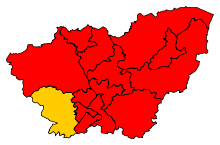People's Republic of South Yorkshire

The People's Republic of South Yorkshire or the Socialist Republic of South Yorkshire, is the name often given to Sheffield and the surrounding area under the municipal socialist administration of Sheffield City Council during the 1980s, led by David Blunkett.[1] The council pursued a social policy radically different from that of Margaret Thatcher's national government, following more closely along the lines of Militant tendency-dominated Liverpool City Council and the Greater London Council led by Ken Livingstone.
The expression was coined by Irvine Patnick,[2][3] a Conservative MP who represented Sheffield Hallam, although it was soon reclaimed by supporters of the council's left-wing policies.[4] Sheffield Hallam was the only seat in South Yorkshire where the Conservative Party was a significant political force, the remaining seats being Labour safe seats or Liberal-Labour marginals.[5] Sheffield City Council and the South Yorkshire Metropolitan Authority were solidly left wing, remaining socialist even as Thatcherism became the dominant political ideology in the country as a whole.
Sheffield City Council constructed large council estates with large numbers of communal blocks of flats based on the streets in the sky philosophy, most famously the Park Hill complex,[6] and set up an extensive network of subsidised transport under the South Yorkshire Passenger Transport Executive.[7] The councils also took more confrontational steps against the Conservative Westminster government, dubbing South Yorkshire a nuclear-free zone and a demilitarized zone,[3] flying the red flag on Sheffield Town Hall on May Day [8] and signing a peace treaty with the city of Donetsk in the Ukrainian SSR, at that point on the other side of the Iron curtain.[3] Both groups of policies - the practical and the symbolic - were sometimes cited as reasons for the nickname. The National Union of Mineworkers moved to headquarters in Sheffield in 1983 in the run-up to the decisive 1984-1985 miners' strike, and the area subsequently became one of the main centres of the strike.[9]
Although it lost some of its relevance following the Labour party's shift towards New Labour and the expulsion of the far-left elements of the party, along with the replacement of Thatcherism with the more moderate Majorism and Blairism, the name remains in use for the area, which is still dominated by the political left. As the United Kingdom general election, 2010, South Yorkshire does not have a single Conservative MP, and the only seat not held by Labour is Sheffield Hallam, now held by Liberal Democrat leader and Deputy Prime Minister Nick Clegg.[10]
See also
References
- ↑ Linda McDowell (2011). Redundant Masculinities? Employment Change and White Working Class Youth. ISBN 1444355597.
[...] local politics in Sheffield were dominated by a particular form of radical municipal socialism, gaining the city a brief but prestigious reputation as the Socialist Republic of South Yorkshire.
- ↑ Department of the Official Report (Hansard), House of Commons, Westminster. "House of Commons Hansard Debates for 19 May 1997 (pt 17)". Publications.parliament.uk. Retrieved 2009-10-11.
- ↑ 3.0 3.1 3.2 Justice of the Peace Ltd (1983). Local Government Review 147: 99.
Councillor Irvine Patnick, the leader of the minority Tory group on the South Yorkshire Metropolitan County Council, apparently makes regular reports to the national chairman of his party and other Conservative high-ups on the situation in that beleagured county which he refers to either as the Socialist Republic of South Yorkshire or (since the authority declared South Yorks to be a demilitarised and nuclear-free zone) Peace County.
Missing or empty|title=(help) - ↑ Peter Lazenby (2012-08-31). "Generations Unite". Morning Star.
The steel city - much of its steel industry wrecked under Thatcher - was at the heart of what used to be proudly called the Socialist Republic of South Yorkshire.
- ↑ Robert Waller (1985). The Atlas of British Politics. p. 135. ISBN 0709936095.
The Conservatives can win only one seat in the so-called "Socialist Republic of South Yorkshire".
- ↑ Massimiliano Mollona (2009). Made in Sheffield: An Ethnography of Industrial Work and Politics. p. 65. ISBN 1845455517.
- ↑ Martin Loney and Robert Bocock (1991). The State or the market: politics and welfare in contemporary Britain. p. 281. ISBN 0803986424.
In contrast Labour did have effective control of public transport in the metropolitan counties following the 1981 elections, and their aim, indeed the achievement of the 'Socialist Republic of South Yorkshire', was to run a cheap, efficient and extensive public transport service.
- ↑ "Radio 4 - Factual — Children of the Red Flag". BBC. 2006-10-16. Retrieved 2009-10-11.
- ↑ Seumas Milne (2004). The Enemy Within: The Secret War Against The Miners. p. 170. ISBN 1844675084.
Sheffield, at the centre of the country's largest coalfield and renowned at the time as the capital of the 'socialist republic of South Yorkshire', offered by far the best deal and it was there that the NUM set up shop in the spring of 1983.
- ↑ Bryon Criddle (2002). Almanac of British Politics 7. p. 302. ISBN 0415268338.
The 'Socialist Republic of South Yorkshire' has not always been as solidly Labour as it is now, with just one Liberal Democrat seat in the shape of Sheffield Hallam breaking the monopoly.